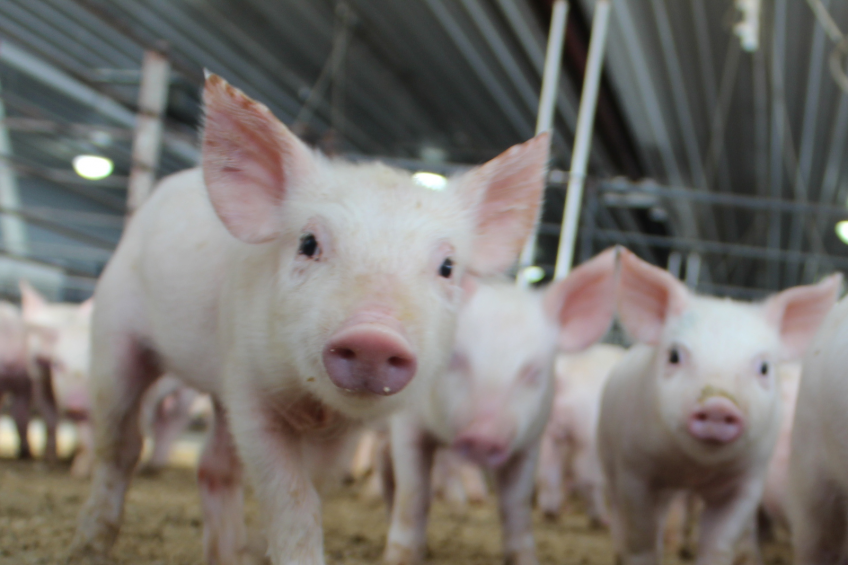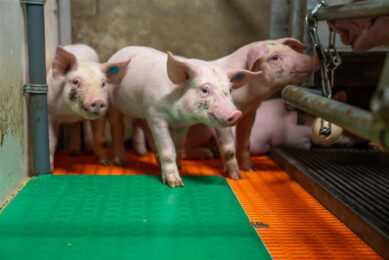Helping challenged pigs to avoid dehydration

With Porcine Epidemic Diarrhoea virus (PEDv) still present in many pig herds in the US, Canada, Mexico and Asia, the danger of ?dehydration is present every day. Hydration and early nutrition are key in helping young pigs not only overcome these stressful situations, but also the stress of weaning.
By Dan McManus, DVM, young animal
specialist-swine for Purina Animal Nutrition, United States
The weaning period is a critical part of the production phase. Current disease challenges can make this transition even more stressful for young pigs. Pigs that are impacted with Porcine Epidemic Diarrhoea Virus (PEDv) experience severe diarrhoea, vomiting and reduced feed intake, resulting in extreme dehydration.
Without supportive therapy, almost 100% mortality rates have been measured in infected pigs less than four weeks of age.
How can we help dehydrated and stressed pigs overcome this challenge? And the challenges associated with weaning, transportation and environmental changes? The answer may come down to the basics: a comfortable environment, palatable feeds and hydration support.
Dan McManus, Purina Animal Nutrition: “When dealing with challenged pigs, the importance of the environment is magnified.”
Comfortable & clean
When dealing with challenged pigs, the importance of the environment is enlarged, meaning any mistakes may become magnified. To help pigs overcome stress challenges, examine and redefine targets for success.
Health-challenged pigs need a warmer environment than normal, healthy weaned pigs of the same age. For challenged pigs, nurseries should be 29°C (85°F), mats in wean-to-finish barns should be 29-32°C (85-90°F) and, as pigs age, barn temperature can be decreased to 26-27°C (78-80°F).
Maintain consistent and adequate ventilation to remove undesirable compounds such as ammonia, dust and pathogens. Strive for a clean, dry, draft-free environment with access to clean, high-quality drinking water.
Conduct a thorough health check on each pig every day. Use a pass/fail grade for each. Remove any that fail from the group and manage these fallouts in a separate group.
In addition, on day 3 or 4 post-weaning, evaluate each pen of pigs for fallouts. Look for pigs that appear to not be gaining weight, or are falling behind. Remove these fallout pigs from the group and provide supportive care. Conduct a second pen evaluation at day 10 or 11 post-weaning. Again, remove any pigs falling behind and provide supportive care.
Provide a palatable feed
Feed intake is low the first five days post-weaning. In research trials on weaned pigs averaging 5.3 kg (11.7 lbs), feed intake was less than 45 g (0.1 lbs) per pig per day in the first two days. Feed intake increased to 270 g (0.6 lbs) per head per day by day eight. A key in mitigating mortality in challenged pigs can be to decrease the number of days off-feed.
Creep feeding can decrease the post-weaning lag as it provides familiarity with feed before the transition. Palatability and familiarity of the feed can help pigs visit the feeding area. It is advisable to select a pre- and post-weaning ration that is highly palatable with complex ingredients to encourage feed consumption and jumpstart the digestive tract.
We recommend providing creep feed three to five days prior to weaning at a rate of 680 g to 1.13 kg (1.5 to 2.5 lbs) of dry feed per day per litter. Offering dry feed pre-weaning can create eaters and ease the transition onto a solely dry feed diet. Providing this start is designed to help pigs transition onto an easily digestible starter feed post-weaning.
Support hydration
Research shows that only 51% of pigs consume water 25 hours post-weaning. For challenged pigs, this delay in hydration can be deadly.
Any delay in water consumption can be problematic because a pig’s bodyweight is about 55% water. In young, lean pigs bodyweight can be up to 70% water. If a pig loses just 15% of its water weight, mortality rates may rise. For pigs impacted by PEDv, water levels drop significantly very quickly. That’s where electrolytes can help – a statement supported by the US National Pork Board (NPB).
Feeding gel on mats can help pigs transition onto solid feeds by encouraging eating in groups. It is recommended to feed gel for at least 2 days pre-weaning; for the first 5 days post-weaning; and one day after vaccination.
Photo: Purina Animal Nutrition
Electrolytes provide nutrients such as sodium, chloride, potassium, calcium and magnesium which can help minimise the impacts of stress. Electrolytes added to a water medicator can be an effective tool to help challenged pigs stay hydrated. Researchers at the Purina Animal Nutrition Center recommend providing electrolytes post weaning for five to seven days.
In pigs experiencing PEDv or other viruses, supportive therapy with electrolytes is even more critical. Electrolytes may be administered until pigs no longer show symptoms of the disease. It takes young pigs about 21 days to regrow its villi from an attack of a virus. That means producers may need to administer electrolytes during that entire time to help pigs address the health challenge.
When provided electrolytes during a University of Manitoba study, water consumption levels increased significantly. Early weaned piglets drank more water with electrolytes in the first three days post-weaning (3.748 l/pig/24 h) than tap water (836 ml/pig/24 h).
Hydration support also comes in gel form. The gel supports hydration and nutrition with a formulation that is 2/3 water and 1/3 solids. This combination aids in the transition to dry pellets, helps keep pigs hydrated and supporting intestinal health. Pigs can be started on the gel while still nursing. Doing so helps lessen the demands on the sow while ensuring adequate hydration and nutrients for the pigs.
Research conducted at the Purina Animal Nutrition Center shows multiple benefits of offering gel to weaned pigs, including:
- Pigs fed gel consumed more feed and experienced higher average daily gains than pigs not consuming gel in the first four to seven days.
- Pig weights were higher at day 36 for pigs that received gel compared to those that did not.
- Pigs fed gel during the nursery period experienced 55.5% fewer removals.
- Providing gel to pigs less than 4.5 kg (10 lbs) or more than 5.9 kg (13 lbs) at weaning resulted in 1.74 and 1.5 kg (3.83 and 3.3 lbs) heavier finishing weights than their counterparts who did not receive the gel.
- Pigs fed gel prior to post-weaning vaccinations had higher feed intakes from days 8 to 14 post-weaning. Their counterparts who did not receive gel experienced three days of decreased feed intake following vaccination. As a result, at exit from the nursery gel-fed pigs were 590 g (1.3 lbs) heavier.
In each of these trials, the benefit to the pigs came through quicker transition onto solid feeds. This shows that keeping pigs comfortable and hydrated can help them find feed and overcome a challenge.
[Source: Pig Progress Vol 30 nr 10, 2014]











